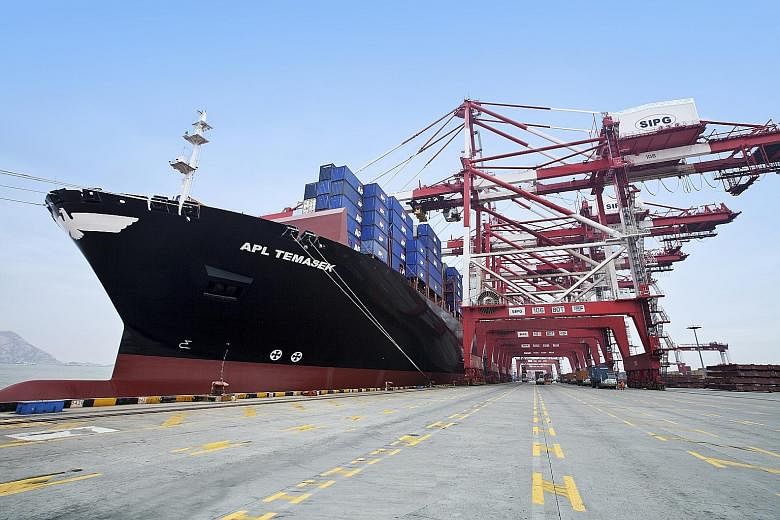In its heyday as recently as a decade ago, home-grown shipping line Neptune Orient Lines (NOL) was sailing ahead with confidence on the world's premier trading routes.
Back then, NOL was ranked among the five largest global carriers - in a business harking back to Singapore's origins as an entrepot, or transshipment, port. It was so well-regarded that national investment firm Temasek Holdings in 2004 aggressively lifted its stake to more than 50 per cent, even launching a surprise $2.8 billion cash offer at $2.80 a share.
Today, however, NOL finds itself navigating treacherous waters. The carrier has gone from being one of the industry's strongest profit leaders to one struggling to stay afloat.
Temasek, too, which holds a 67 per cent stake in the firm, has taken a buffeting: It is set to sell NOL to France's CMA CGM for less than half the 2004 share price it paid to lift its stake. The offer price, announced on Dec 7, is $3.38 billion or just $1.30 a share.
So what has happened to rub the lustre off NOL - once ranked among the country's golden cash cows, underpinning national development?
CLIMBING TO THE TOP
NOL, founded in 1968 as Singapore's national flag carrier, was set up by the Government with the aim of cementing Singapore's status as a global trading hub.
Its mission was to facilitate industrial development by carrying the nation's trade at fair freight rates, while maintaining its own ships to carry cargo in times of crisis.
By the mid-1970s, as containerisation radically changed the profile of the industry, NOL had expanded its humble five-vessel fleet to comprise some 20 ships. It turned its first profit under managing director Goh Chok Tong, who went on to become Singapore's second Prime Minister.
The firm in 1975 entered Asia- Europe trade as part of the ACE consortium, known as the "third force" in the container shipping world then. Six years later, it went public on the Singapore Stock Exchange (now known as the Singapore Exchange), raising $155 million. It remains the largest shipping company listed here to date.
BUYING APL
One of the biggest highlights through NOL's history was its US$825 million acquisition of then nearly 150-year-old American President Lines (now known as APL) in 1997. Many analysts saw it as an expensive buy-out for a struggling carrier, but the deal gave NOL the critical mass to compete globally on major container trades.
Former deputy chief executive Lim How Teck tells The Straits Times: "People were saying that we had swallowed an elephant and won't be able to move for months.
"But in hindsight, it was a great buy. APL was worth three or four times its value then. For us, it was more about the long-term view."
With APL, NOL gained a vast network of logistics support and key terminals in the United States and Asia. It also helped "push NOL onto the global stage" and widen its reach, notes Mr Rahul Kapoor, director at Drewry Maritime Services.
NOL's ships still operate under the APL brand today.
But Mr Lim, who was with NOL from 1979 to 2005, acknowledges that "operations became expensive" after the acquisition.
He recalls, for instance, how both male and female staff used to bunk in the same room on overseas work trips to save on costs.
"That changed after we bought APL. We started to do things the American way, so we stopped sharing rooms because suddenly, the issue of possible sexual infringement was there."
NAVIGATING THE CYCLES: MORE MISSES THAN HITS?
An industry depression left NOL battered in the early 2000s, and then-chief executive Flemming Jacobs was asked to leave amid losses in 2003. Former politician David Lim stepped in to take over the role.
Nonetheless, the firm was back in the black with a record US$429 million profit that same year - one that preceded its later successes, which CTI Consultancy partner Andy Lane believes was due to "the foundation laid by Jacobs through some of shipping's toughest years".
Such was NOL's allure during the mid-noughties - against a backdrop of a boom in trans-Pacific trade - that Temasek shelled out $2.80 per share in 2004 to raise its 30 per cent stake in the firm to 68.6 per cent.
Mr Lane notes that NOL was highly regarded in the industry at that time, and that Maersk, which he was then working for, had benchmarked itself against NOL's business model.
It was the global financial crisis in 2007 that dealt a heavier blow to the company, says Mr Lane, given that NOL was "clearly not fit enough for the challenges ahead", losing both market share and profitability.
NOL nearly took another misstep when it mounted a US$7 billion bid for Germany's Hapag-Lloyd - seen by many as grossly overvalued - although it pulled out of the process.
"It would have been suicidal if the bid had gone through," says Mr Lane. "At this point, NOL had gone from champions to one of the worst performers in terms of profitability, all in less than five years. It simply cannot have been making the right decisions during this period."
While 2010 was a rebound year for all lines, including NOL, the year that followed would mark the start of a protracted slump which has left the company bleeding red ink for the past four years.
The company inherited by former army general Ng Yat Chung in 2011 was saddled with high debt levels - to the point NOL had to sell its profitable APL Logistics unit to Japan's Kintetsu World Express for US$1.2 billion (S$1.7 billion) in February this year, in a bid to preserve the shipping line.
"The container shipping industry is in the midst of an overcapacity crisis and it will worsen next year," notes Mr Kapoor, adding that lines globally have to cope with the "double whammy" of slowing demand too.
As for NOL, both its volumes and freight rates have been heading south, he says. "It's a toxic combination that the management has failed to arrest and Temasek appears to have seen the writing on the wall that a turnaround is not imminent."
CHANGING TIDES
The current downturn has come with new challenges, where scale and lean cost structures are king in a highly competitive industry.
But NOL has not been able to keep abreast of change, notes Mr Kapoor, as it continues to have high fixed costs compared with its rivals.
Mr Lane also points out that the company puts its biggest ships on the Asia-Europe routes, where returns are the lowest, instead of more profitable courses. "In today's world, you can't be a global player without thinking on a wider scale."
That NOL has seen frequent and multiple changes at its helm since 2003 likely offered little help as well, notes Mr Lim Meng Kong, NOL's first representative in the United States during the late 1970s.
When Mr David Lim left in 2006, German Thomas Held took over the reins for two years, followed by American Ron Widdows in 2008 and later, Mr Ng.
"There was too much of a leadership change in just a matter of a few years," says Mr Lim, who remained in the industry after he left NOL in 1984. "This would have made it hard for there to be continuity."
Meanwhile, NOL's strategic significance as a national flag carrier has diminished - a possible impetus for Temasek to cut the loss-making line out of its portfolio. Credit Suisse analyst Timothy Ross, as quoted in The Business Times, used the potent seafaring metaphor of Temasek "cutting loose the albatross" of NOL, a reference to a burden released.
This marks a striking contrast to Singapore's earlier years, when having a national shipping line was crucial to the country's growth.
Despite all the red ink and the bleak industry outlook worldwide, market watchers agree NOL is still an attractive asset.
The carrier is, after all, South-east Asia's largest container shipping firm, operating about 90 vessels. It has retained a strong presence and market share in the trans-Pacific and intra-Asia lanes - a "part of the world where CMA CGM is underepresented", notes Mr Ross.
ALTERNATIVE ROUTES?
News that NOL is to be sold, for some, was tough to stomach.
"NOL was one of those companies the Government set up in its efforts to globalise the country," says Mr William Tay, a former executive vice-president at NOL during the latter part of his 20-year career there.
"It should be continued, like Singapore Airlines or DBS Bank. You mean we really don't have the people to run our own shipping line?"
Mr Lim How Teck thinks selling NOL two or three years down the road could have fetched better prices, given that the industry is now knee-deep in the cyclical trough.
Or, it could have "carved out" and sold segments of its business separately to glean better gains, rather than sell the firm as a whole, notes the shipping veteran. "They can sell the terminals in Asia and the US - which the PSA, I think, would be keen to buy - and then the container business on its own."
NOL owns five terminals across Japan, Taiwan and the US.
"But there's the worry that if they don't sell (NOL) now, there may not be a suitor later," adds Mr Lim.
"As part of the old guard that helped to grow the company for so many years, it's sad that NOL is going to disappear.
"Unfortunately, I do not have the money to do a national buy-out," he says, with a laugh. "At least the price is fair."


